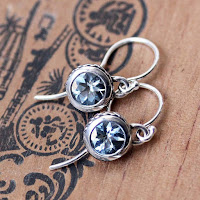 |
| Photo credit: Tx Rockhound |
Yikes! How did it get to be (almost – if it weren’t a leap year) March!?
Despite having lots of birthstone jewelry for my children, I don’t own any from this month – in which my husband was born – so I’m in process of resolving that situation…
I’m signed up to take the next installment of metalsmithing classes at Creative Side – Fabrication 201 – which includes setting a stone with corners. So, in anticipation of that project, I’ve purchased a lovely triangular cabochon with an eye to making a pendant.
 As with previous projects, I've done a little sketching. With a nod to my husband, I'm going to call this one "lucky charm" and put a small heart on the reverse. I'm still thinking about the bail...I've become very taken with them lately, as another way to take a necessary component and turn it into something a little more special and unique.
As with previous projects, I've done a little sketching. With a nod to my husband, I'm going to call this one "lucky charm" and put a small heart on the reverse. I'm still thinking about the bail...I've become very taken with them lately, as another way to take a necessary component and turn it into something a little more special and unique.But I digress...aquamarine is a member of the beryl family (like emerald) and gets its name from its watery-blue color. My stone - which was relatively inexpensive - shows inclusions and a fair amount of green color. Stones used in fine jewelry are graded - like other precious gems - on color and clarity, so must be bluer and inclusion free. An interesting aspect of aquamarine is that the blue color becomes more intense as the stone increases in size - which also results in much higher prices in large stones.
 |
| Photo credit: Cecile Raley Designs |
 |
| Photo credit: Metalicious Jewelry |
Until next time.

No comments:
Post a Comment